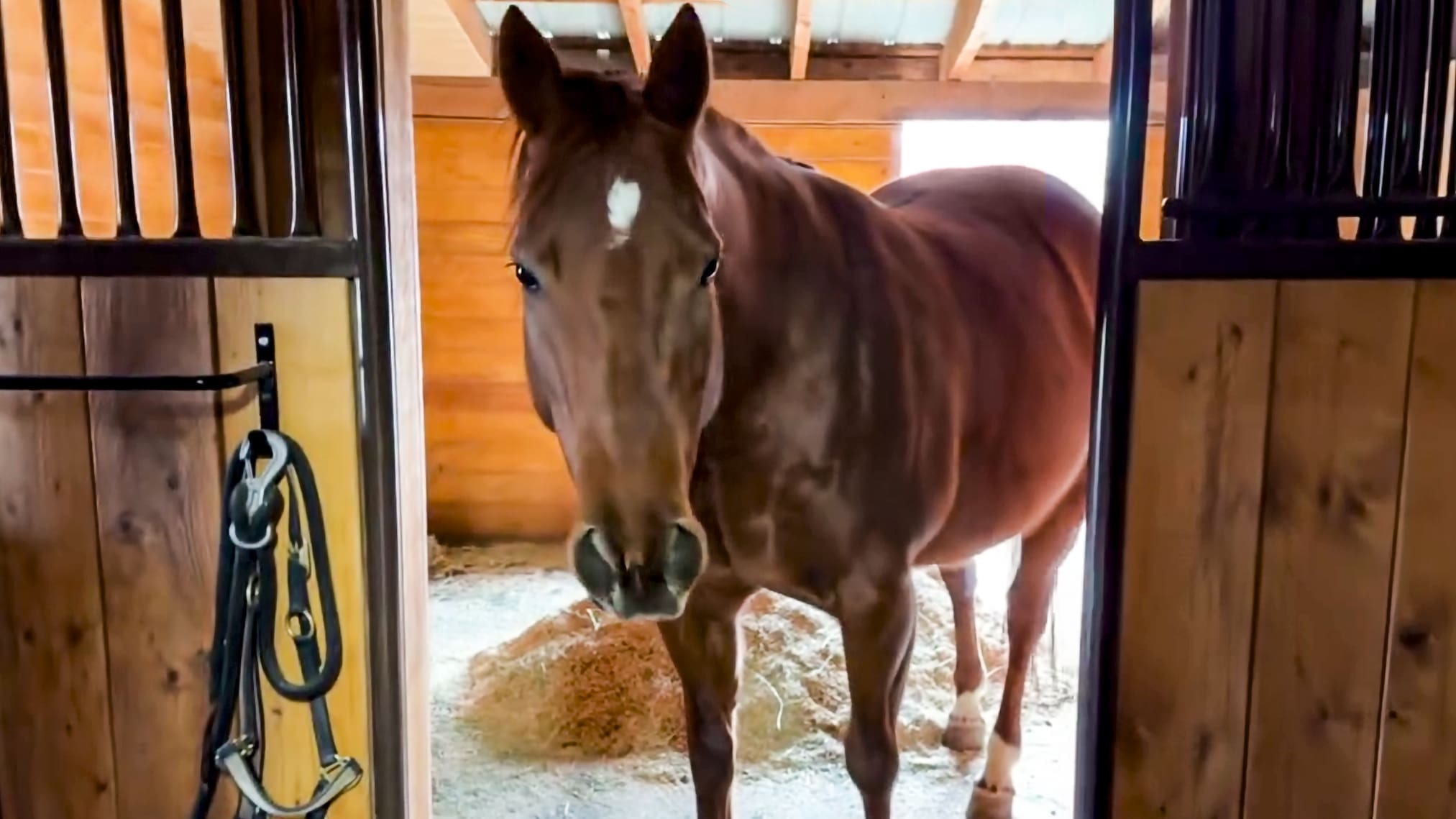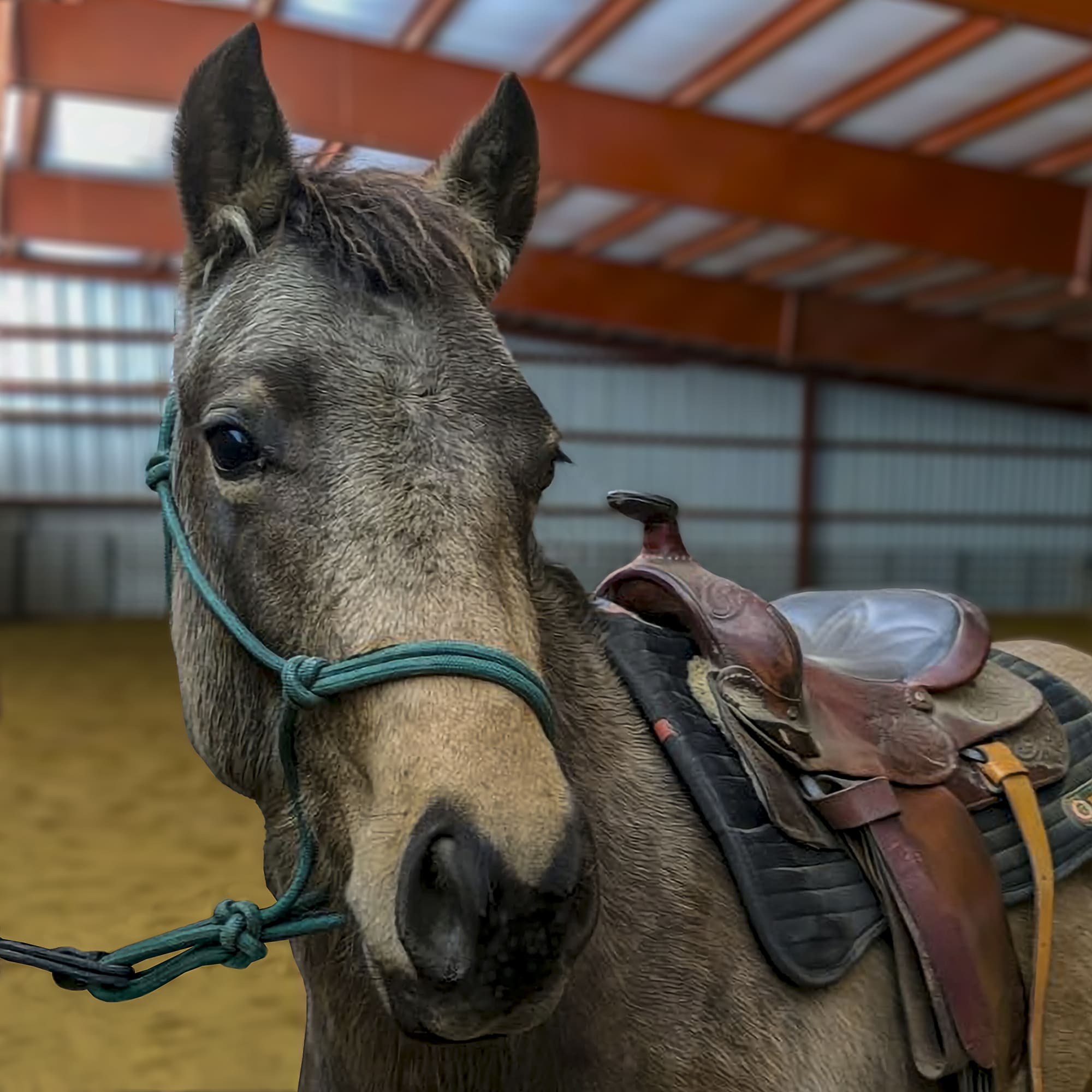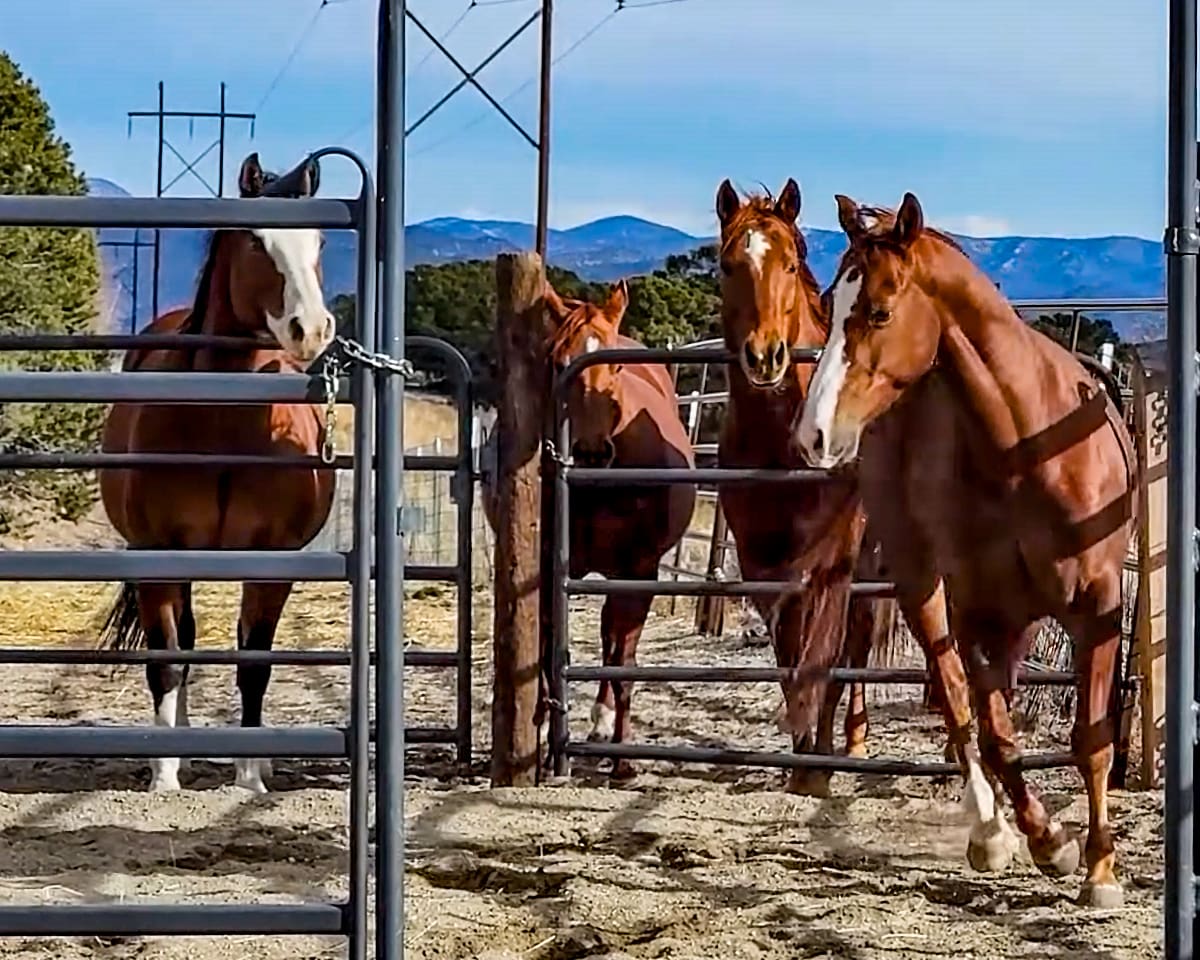Question Category: Issues from the Ground
Question: I know I need to teach my horse to respect me while I’m leading him at halter. He’s pushy and pulls me. How do I get started? How can I teach my horse the skills he needs to behave while I’m leading him?
Answer: In this article, we’ll explore the groundwork you can do with your horse from the lead line, to refine your relationship with your horse and bring it to a whole new level.
This type of ground training is done with a rope halter and a minimum 12’ training lead (this is the one I recommend you purchase) and involves standing, leading, circling and lateral work. Lead line work is done to establish what I like to call the “Three R’s of Training: Respect, Relationship and Responsiveness.”
Lead line work is all about moving the horse out of your space to achieve subordinance and respect from the horse and establish yourself as the leader of your herd of two. Through this type of training, you will learn to control the horse’s entire body, his feet, his nose, his shoulder and his hip. As you gain more control over the horse, you will be less reliant on the halter and lead and the horse will respond to simple hand gestures.
CONTROL THE FEET
The first step is to gain control over the horse’s feet so that they only move when you ask. You’ll start by asking the horse to stand still like a statue. It is important to give a clear signal with your body language that you want the horse to stand by positioning yourself in front and to the side of the horse, with your toes facing the horse’s shoulder. This is a clear indication to the horse that you are not going anywhere. Do not stand close to the horse and do not try to hold him in place with the lead. Stand back with plenty of slack in the lead and simply correct him every time he moves.
If the horse moves any foot in any direction, snap the lead hard (do not jerk the rope, just pop it, sending a wave through the rope) and firmly say “whoa.” When you snap the rope, the halter knots will bounce on the horse’s face, giving him an aversive stimulus. If your horse has moved in a direction that he wanted to go, you need to back him up to where he was originally so that he is not gradually creeping toward where he wants to be.
In short order, with consistent, calm, but firm correction, he will learn to keep his feet still when you ask him. Gradually increase your distance from the horse so that he is not under the impression that you are holding him there, but instead he is standing voluntarily merely because you asked him to. Practice this for sometime every day until you have total control over your horse’s feet.
CONTROL THE NOSE
As you begin to get control of your horse’s feet, you can also begin to control his nose. My rule with all horses is that “you must keep your nose in front of your chest at any time that I am working around or riding you.” Horses are very good at following rules when the rules are clearly defined and consistently reinforced. As you are working on your horse standing, also insist that he keep his nose in front of his chest, by giving a simple and mild correction every time he moves it in either direction.
When the nose moves away from you, simply shake or oscillate the rope until it comes back into place. When the nose moves toward you, it is a bigger infraction because he is moving into your space, a cardinal sin. To move the nose away from you, simply twirl the tail of your rope like a propeller blade, slowly moving it toward his nose. At this point, he has two choices; he can move his nose out of your space or get hit by the propeller blade. You are not hitting the horse with the rope; you are using the rope to define your space and if the horse chooses not to move out of your space, he may get hit with the rope.
Again, with a clearly defined rule and consistent correction, in short order your horse will learn to keep his nose in front if his chest. Be sure to enforce this rule at any time that you are working around the horse or riding him. Often the first thing that happens when a horse misbehaves is that he moves his nose in the direction he wants to go or into your space. Controlling the nose will lead to a well-mannered horse that is entirely focused on you and not looking around for trouble.
CONTROLLING THE FEET WHILE MOVING
The next step in this process is to work on leading. A truly subordinate horse will prefer to walk directly behind you, but this is not a safe place for you. He who stands in front of a horse has never been run over by a horse before. We want to teach the horse to walk beside us, not behind, so that your torso is positioned halfway between the horse’s nose and shoulder. We want the horse to stay in that position, matching you step for step, without you pulling him forward or holding him back. Again, we need to set the rule and boundaries for the horse and correct him any time he is not in the right place.
There are basically two types of horses: one with too much go and one with too much whoa; push to go or pull to whoa. I am more concerned with the horse that is getting in front of you dragging you everywhere. A subordinate horse would never get in front of a dominant horse so if your horse is dragging you around, it is an indication that he does not accept you as his leader.
For the horse to stay behind you at the same time that he walks beside you, it is important that you keep your leading hand up and out in front of you. This leading hand will indicate the most forward boundary your horse is allowed to cross. Do not try to hold him back. Instead, when the horse gets in front of your hand, simply snap the rope hard and turn around and back the horse vigorously out of your space. Once you have consistently reinforced this forward boundary a few times, your horse will learn to watch your hand and you can give him a warning by simply lifting a finger up and he should slow down and back off. Soon, your horse should be taking a step back every time you stop.
If your horse is lagging behind you, simply bump the lead until he makes an effort to catch up. As soon as you see the slightest effort that he is trying to catch up, be sure he finds a release; you can always bump again but he needs to understand that if he keeps up with you, the halter knots will not be bouncing on his face.
As you practice leading, do lots of transitions from halt to walk to halt, from walk to trot to walk. Be sure to use your body language to signal the horse and take several seconds for each cue. Don’t just slam on the brakes and stop, your horse will never be able to move with you. Instead, to cue him to stop or slow down, lift your shoulders, then slow your feet, then gradually bring your feet to a stop. For the upward transition, move your eyes, shoulders and hands forward first, then slowly begin to move your feet.
You’ll also want to turn the horse a lot as you lead him, always turning him away from you, to reinforce the horse moving out of your space. Keep your hands up and in between you and the horse and poke him in the face with your fingers if he doesn’t get out of your space. As he turns better, make your turns smaller until the horse begins to pivot on his hindquarters. You should practice all of this leading work from the offside of the horse as well, so that he leads equally well from both sides.
CONTROL THE HIP
To begin controlling the hip, first you’ll disengage the horse’s hindquarters. This simply means to ask the horse to move his hip away from you and cross his hind legs. Disengagement takes away the horse’s forward motion and causes submissiveness in his mind. To disengage the horse, step back behind his balance point and ask him to move forward, then gently lift the lead to bring the nose toward you; this will cause his hip to move away from you and his hind legs to cross. Ask him to disengage from both sides.
Next, you’ll work on driving the horse around you in a circle. Step behind the balance point of the horse (see the March article) and ask him to move forward. Give him plenty of slack on the lead so that he moves off in a circle around you. You are driving the horse, so you should be moving toward his hip as he moves away from you. Make sure you are not backing up or trying to lead the horse; you are pushing him away from you.
Be very careful not to get within kicking distance of the horse’s hind feet. It would be very natural for the horse to kick out in defense if you get too close and try to slap him on the rear to make him go. If you have a lazy horse, you may want to use a stick or a flag (see the February issue on tools of NH) to keep yourself at a safe distance.
Drive the horse in a circle around you in both directions, at a walk and trot, until he is moving steady and willingly with his nose bent slightly toward you and he is keeping slack in the rope. This is also a good time to teach the horse to halt on the voice cue. While circling, take one step in front of the horse and plant your feet at the same time you say, “whoa.” If he does not immediately stop, snap the rope to reinforce your verbal and body language cue. Do not use the rope first because we want him to stop off the cue, not off the rope.
Once you can circle and stop well in both directions, you can ask the horse to change directions by switching your hands on the lead, bringing his nose toward you, then directing him the other way. Be communicative with your gestures and soon the horse will be changing directions softly, as if he were your dance partner.
CONTROLLING THE SHOULDER
By now, you have already been working on controlling the shoulder by turning the horse away from you while leading and by doing changes of direction while circling. You can gain even more control over the shoulder by asking the horse to cross his front legs and move the shoulder away from you on command.
You can either use the propeller blade pointed at the horse’s shoulder or you can ask him to move his shoulder by lifting up on the lead, directing his nose away from you and asking him to move, then give a gentle poke with your finger to his shoulder as the foot closest to you comes off the ground. Work on moving the shoulder until you can do quarter turns on the hindquarters, then half turns, then full turns. Once you can control his shoulder and his hip, you can begin to ask the horse to side pass.
It may take several weeks of consistent ground work to get your horse to the level that he is moving with you like a dance partner; then you can try all of this work without holding on to the lead. Once you are at this level, you’ll have a horse that is respectful, obedient and is your partner in all things. This level of relationship with your horse takes time and commitment, but is time well spent, as the end result is a horse that is a joy to be around.
Copyright © Julie Goodnight 2000. All Rights Reserved. No part of this website may be reproduced without owner’s express consent.




2 Comments
My horse has decided she doesn’t want to circle around me. She moves her hind feet around if I try to get beside her to start driving her, or she will pin her ears at me and rear up. Yesterday she attacked the flag by rearing and striking it with her front hooves while I was trying to back her up.
She has no respect for me or my space. She also will try to turn and try to bite my leg when I am in the saddle.
She has a 5 almost 6 month-old-filly at her side I am also struggling with. I am one of the first-timers you mentioned in one of articles raising a foal, and spoiling it. Now I am paying the price and need to get a lot more assertive with her as well.
Do I start at the beginning with my mare?
I am a library member; not sure if I am interactive.
Thank you!
Marie
Marie,
Thank you for your correspondence; you are correct your membership is Library Yearly. If you want to upgrade to interactive so you have personal access to Julie we would be happy to discuss that possibility with you please give us a call (800) 225-8827. Yes, you will want to start at the beginning with your mare and then continue to be consistent with her.-TWC